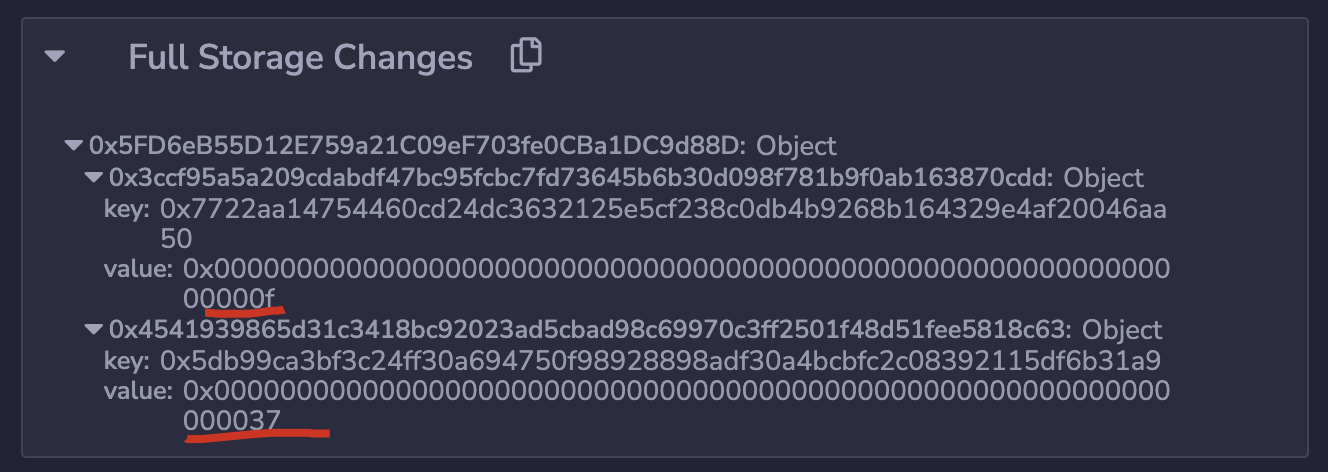第3节:各种类型是如何存储的
Reversing and debugging EVM Smart contracts: How the storage layout works?-part3
小的type会节约slot,但是会增加OPCODE步骤(增加mask步骤),所以不能滥用小byte,否则会适得其反。
1. Simple example
// SPDX-License-Identifier: MIT
pragma solidity ^0.8.0;
contract Test {
uint balance;
uint balance2;
uint balance3;
function modify() external {
balance = 1;
balance2 = 2;
balance3 = 3;
}
}
- 三个元素都是uint256类型,每一个都占用空间为:32字节(256/8 = 32)
- 但是在存储时,每个元素都占用一个独立的slot(每个slot容量为:32字节)
- 所以最终存储事实为:Slot0: 1、Slot1: 2、Slot2: 3,天经地义!
2. using uint8 instead of uint256
// SPDX-License-Identifier: MIT
pragma solidity ^0.8.0;
contract Test {
uint8 balance;
uint8 balance2;
uint8 balance3;
function modify() external {
balance = 1;
balance2 = 2;
balance3 = 3;
}
function modify2() external {
balance2 = 5;
}
}
- 三个元素都是uint8类型,即一个字节,共计:3个字节,远小于一个slot的容量(32字节)
- 所以最终存储为:使用一个slot0:030201
3. Using different types of data
// SPDX-License-Identifier: MIT
pragma solidity ^0.8.0;
contract Test {
uint8 balance;
bytes4 data;
address addr;
function modify() external {
balance = 17;
data = 0xaaaaaaaa;
addr = 0x358AA13c52544ECCEF6B0ADD0f801012ADAD5eE3;
}
}
- Uint8: 1字节,bytes4: 4字节,address:20字节,共计字节数:25,小于一个slot的容量
- 因此最终存储为,slot0: 358aa13c52544eccef6b0add0f801012adad5ee3aaaaaaaa11
- 拆分为:0x358aa13c52544eccef6b0add0f801012adad5ee3, data = 0xaaaaaaaa, balance = 0x11
4. Does the placement of variables count ?
// SPDX-License-Identifier: MIT
pragma solidity ^0.8.0;
contract Test {
uint8 balance;
address addr;
bytes4 data; // 这里的顺序变了
function modify() external {
balance = 17;
data = 0xaaaaaaaa;
addr = 0x358AA13c52544ECCEF6B0ADD0f801012ADAD5eE3;
}
}
- 也是存储在一个slot0中,但是顺序有变化:aaaaaaaa358aa13c52544eccef6b0add0f801012adad5ee311
5. How are stored structs ?
// SPDX-License-Identifier: MIT
pragma solidity ^0.8.0;
contract Test {
struct Values {
uint8 balance;
address addr;
bytes4 data;
}
Values value;
function modify() external {
value.balance = 17;
value.addr = 0x358AA13c52544ECCEF6B0ADD0f801012ADAD5eE3;
value.data = 0xaaaaaaaa;
}
}
Here is the full disassembly of the function
045 JUMPDEST
046 PUSH1 00 |0x00|
048 DUP1 |0x00|0x00|
049 SLOAD |0x00|0x00|
050 PUSH1 01 |0x01|0x00|0x00|
052 PUSH1 01 |0x01|0x01|0x00|0x00|
054 PUSH1 c8 |0xc8|0x01|0x01|0x00|0x00|
056 SHL |0x00.50zeros.0100...00|0x01|0x00|0x00|
057 SUB |0x00.15zeros0tttffff.49f.fffff|0x00|0x00|
058 NOT |0xfffffffffffffff00..49zeros..00|0x00|0x00|
059 AND |0x00|0x00|
060 PUSH25 aaaaaaaa358aa13c52544eccef6b0add0f801012adad5ee311 |0x00...00358aa13...|0x00|0x00|
086 OR |0x00...00358aa13...|0x00|
087 SWAP1 |0x00|0x00...00358aa13...|
088 SSTORE ||
089 STOP ||
- 与普通的layout没有任何区别
6. What about arrays ?
// SPDX-License-Identifier: MIT
pragma solidity ^0.8.0;
contract Test1 {
uint[] values;
// uint value2 in comment
function modify() external {
values.push(7);
values.push(8);
}
}
contract Test2 {
uint value2 in comment
uint[] values;
function modify() external {
values.push(7);
values.push(8);
}
}
数组存储非常特殊,数组存储方式为:
- 如果数组在slot0(上图Test1中,values是在slot0):那么slot0存储数组长度,keccak256(0) + 0存储第0个元素,keccak256(0) + N -1 存储第N个元素
- 如果数组在slot1(上图Test2中,values是在slot1):那么slot1存储数组长度,keccak256(1) + 0存储第0个元素,keccak256(1) + N -1 存储第N个元素

7. How are stored mapping ?
// SPDX-License-Identifier: MIT
pragma solidity ^0.8.0;
contract Test {
mapping(address => uint) balances;
function modify() external {
balances[0xbc5D291D2165f130375B94c62211f594dB48fEF2] = 15;
balances[0x9a8af21Ac492D5055eA7e1e49bD91BC9b5549334] = 55;
}
}
- slot:SHA3(mapping_slot . key)
- keccak256(memory[offset:offset+length])
- offset = Stack(0) = 0, length = Stack(1) = 40

8. conclusion
If you read this entire article, congratulations! It’s not that easy but it worth it.
You now know more about EVM than 99.9% of developers.